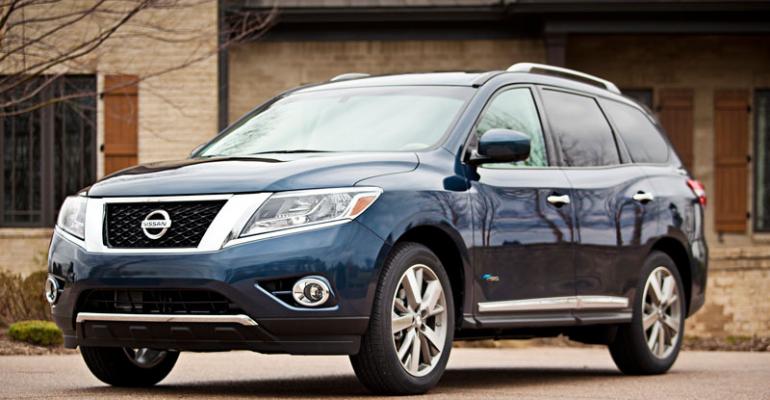Nissan unveils the ’14 Pathfinder Hybrid at the New York International Auto Show, promising the new model will close some of the price gap with conventionally powered vehicles.
The new cross/utility vehicle “is designed as a logical bridge between conventional internal-combustion-engine powertrains and the wider acceptance of hybrid systems,” Pierre Loing, vice president-product planning for Nissan North America, says in a statement.
The Pathfinder Hybrid employs a front-/4-wheel-drive version of the 1-motor, 2-clutch system used in the rear-drive Infiniti M hybrid.
In the Pathfinder the system provides “milder performance and fuel-economy gains at a more affordable price, for a wider customer base,” Loing says.
The Pathfinder Hybrid is rated at 26 mpg (9.0 L/100 km) city/highway combined, falling short of the ’13 Toyota Highlander Hybrid’s 28 mpg (8.4 L/100 km).
Toyota is unveiling its next-generation ’14 Highlander at the New York show, with the promise of improved fuel economy for the hybrid version of the CUV.
Nissan says the use of existing technology will make the Pathfinder Hybrid more affordable. That technology includes Nissan’s 2.5L inline 4-cyl. engine offered in the prior-generation Altima midsize and compact Sentra sedans.
However, in the Pathfinder Hybrid, the auto maker has added a Roots-type supercharger to the engine to generate 250 hp and 243 lb.-ft. (329 Nm) of torque, nearly equivalent to the conventional Pathfinder’s 3.5L V-6, rated at 260-hp, 240 lb.-ft. (325 Nm).
The hybrid also gets a smaller version of longtime Nissan supplier Jatco’s Xtronic continuously variable transmission, which creates space for the model’s integrated motor-clutch. A lithium-ion battery pack is fitted below the CUV’s third-row seat.
The Pathfinder’s front-drive hybrid-system layout is roughly the same as that in the Infiniti M.
A 15kW (20-hp) electric motor is located between the gasoline engine and CVT in the space normally occupied by a torque converter. It also acts as a generator during deceleration.
One clutch is fitted between the gas engine and electric motor, and the second between the motor and CVT.
A direct connection is made between the engine, electric motor and CVT when both clutches are engaged. The electric motor can provide supplemental torque in this scenario, with the “potential for powerful acceleration,” Nissan says.
The unspecified-size Li-ion battery pack, which Nissan classifies as “high input/output” can be “topped up” via regenerative braking.
Nissan says the Pathfinder’s hybrid system is scalable for different segments. Loing cites the possibility of using the front-drive hybrid system in an “urban compact or sedan,” incorporating a downsized engine and upsized motor and battery for greater electric-only range in stop-and-go driving.
As with the conventional ’13 Pathfinder, the ’14 hybrid model also will be available with all-wheel-drive and in SV, SL and Platinum grades. However, there is no base S-grade hybrid.
The Pathfinder hybrid’s standard tow rating is 3,500 lbs. (1,588 kg), compared with 5,000 lbs. (2,268 kg) for the ’13 gas-engine-only Pathfinder.
Several features unique to the hybrid include light-emitting-diode taillights, special “PUREDRIVE” hybrid badges and information screens indicating such data as how much power is being regenerated by braking.
The Pathfinder Hybrid joins the conventionally powered models late this summer at Nissan U.S. dealers, with an expected $3,000 premium over the ’13 Pathfinder, which starts below $30,000 and can top $40,000 if fully equipped.
Also on Nissan’s New York stand is a NV200 taxi with wheelchair accessibility.
At last year’s New York show, Nissan was the target of protesters who criticized the NV200, selected as New York’s “Taxi of Tomorrow” and going into service this fall, for not being design-friendly to the physically challenged.
The NV200 Mobility NY Taxi shown today was developed in conjunction with BraunAbility of Indiana, which Nissan calls the market leader in wheelchair-accessible vehicles.
The NV200 Mobility has a ramp that extends manually, after the taxi operator flips down the second-row seatback, pulls a release handle to tumble the seat forward and opens the rear doors.
Protesters have taken issue with the latter point, saying it is dangerous for wheelchair-bound passengers to enter and exit a taxi from the back and onto the street.
Nissan touts the safety of the NV200 Mobility, saying the ramp exceeds the regulations specified by the Americans with Disabilities Act, as well as its industry-first integrated restraint system “for the safe and quick securement of wheelchairs.”





